
Destroyer escort (DE) was the United States Navy mid-20th-century classification for a 20-knot (23 mph) warship designed with endurance to escort mid-ocean convoys of merchant marine ships. The Royal Navy and Commonwealth forces identified such warships as frigates, and that classification was widely accepted when the United States redesignated destroyer escorts as frigates (FF) in 1975. From circa 1954 until 1975 new-build US Navy ships designated as destroyer escorts (DE) were called ocean escorts. Destroyer escorts and frigates were mass-produced for World War II as a less expensive antisubmarine warfare alternative to fleet destroyers. Similar types of warships in other navies of the time included the 46 diesel-engined Kaibōkan of the Imperial Japanese Navy., 10 Kriegsmarine escort ships of the F-class and the two Amiral Murgescu-class vessels of the Romanian Navy.

The Isles-class trawlers were a class of naval trawler used by the Royal Navy, Royal Canadian Navy and Royal New Zealand Navy during World War II.

The Town-class destroyers were a group of 50 destroyers of the Royal Navy and the Royal Canadian Navy that were in service during the Second World War. They were transferred from the United States Navy in exchange for military bases in the British West Indies and Newfoundland, as outlined in the Destroyers for Bases Agreement between Britain and United States, signed on 2 September 1940. They were known as "four-pipers" or "four-stackers" because they had four smokestacks (funnels). Later classes of destroyers typically had one or two.
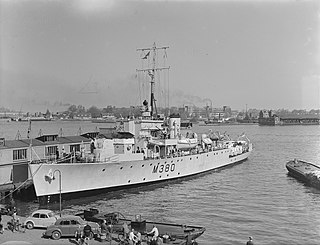
HMS Mariner was a reciprocating engine-powered Algerine-class minesweeper during the Second World War. Laid down as HMCS Kincardine for the Royal Canadian Navy she was transferred on completion to the Royal Navy as HMS Mariner. She survived the war and was sold to Myanmar in 1958 as Yang Myo Aung.

The Algerine-class minesweeper was a large group of minesweepers built for the Royal Navy (RN) and the Royal Canadian Navy (RCN) during the Second World War. 110 ships of the class were launched between 1942 and 1944.
The Cape class consists of two escort maintenance ships of the Royal Canadian Navy (RCN). The ships were built in Canada as Beachy Head-class maintenance ships for the Royal Navy, but were acquired by Canada in 1952. They were commissioned into the RCN in 1959 as HMCS Cape Breton and HMCS Cape Scott. Cape Scott served on the east coast until 1972, after which the ship became a stationary repair vessel at Halifax, Nova Scotia until 1975. The vessel was broken up in 1978. Cape Breton served initially as a school ship on the east coast before transferring to the west coast of Canada in 1959. The maintenance ship remained in service until 1964, when she was laid up at Esquimalt, British Columbia as a maintenance facility. Cape Breton remained in this service until 1993. The vessel was then sold for use as an artificial reef and sunk off the coast of British Columbia.
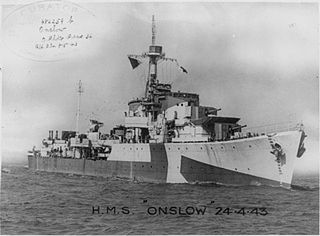
HMS Onslow was an O-class destroyer of the Royal Navy. The O-class were intermediate destroyers, designed before the outbreak of the Second World War to meet likely demands for large number of destroyers. They had a main gun armament of four 4.7 in guns, and had a design speed of 36 kn. Onslow was ordered on 2 October 1939 and was built by John Brown & Company at their Clydebank, Glasgow shipyard, launching on 31 March 1941 and completing on 8 October 1941.

The British Royal Navy operated large numbers of small Motor Minesweepers (MMS) during the Second World War, in two major classes, the first with 105 ft (32 m) hulls and the second with 126 ft (38 m) hulls. Intended to counter magnetic influence mines in coastal waters, they had wooden hulls.

A danlayer was a type of vessel assigned to minesweeping flotillas during and immediately after World War II. They were usually small trawlers, fitted for the purpose of laying dans. A dan is a marker buoy which consists of a long pole moored to the seabed and fitted to float vertically, usually with a coded flag at the top.

Naval trawlers are vessels built along the lines of a fishing trawler but fitted out for naval purposes; they were widely used during the First and Second World Wars. Some—known in the Royal Navy as "Admiralty trawlers"— were purpose-built to naval specifications, others adapted from civilian use. Fishing trawlers were particularly suited for many naval requirements because they were robust vessels designed to work heavy trawls in all types of weather, and had large clear working decks. A minesweeper could be created by replacing the trawl with a mine sweep. Adding depth charge racks on the deck, ASDIC below, and a 3-inch (76 mm) or 4-inch (102 mm) gun in the bow equipped the trawler for anti-submarine duties.
Naval trawlers were purpose-built or requisitioned and operated by the Royal Navy (RN), mainly during World Wars I and II. Vessels built to Admiralty specifications for RN use were known as Admiralty trawlers. All trawlers operated by the RN, regardless of origin, were typically given the prefix HMT, for "His Majesty's Trawler".

The Portuguese-class trawlers of World War II were naval trawlers, built in Portugal for the Royal Navy.

RHS Kanaris (L53) was a Type III Hunt-class destroyer that was originally built for the British Royal Navy as HMS Hatherleigh.
The Basset class of Admiralty trawlers was a class of trawlers built for the British Royal Navy prior to the outbreak of Second World War. The vessels were intended for use as mine-sweepers and for anti-submarine warfare, and the design was based on commercial types, adapted for naval use. The purpose of the order was to make use of specialist mercantile shipyards to provide vessels for war use by adapting commercial designs to Admiralty specifications.

The Axe class was a class of naval trawlers used by the Royal Navy of the United Kingdom during the Second World War.

HMS Albrighton was a Type III Hunt-class destroyer built for the British Royal Navy. She entered service in February 1942, first carrying out an attack on German ships in the English Channel then taking part in the Dieppe Raid, rescuing survivors from the sinking destroyer HMS Broke. Albrighton was next assigned to search for and destroy the German auxiliary cruiser Komet, then escorted a convoy to Gibraltar in prevision of the Allied landings in North Africa. Between December 1942 and April 1943, she participated in the sinking of three more Axis ships with the First Destroyer Flotilla. During the Normandy Landings in June 1944, Albrighton served as a headquarters ship, then sank two German trawlers in the weeks after the invasion. After being converted to a destroyer in early 1945, she was damaged in a collision with a Landing Ship, then was assigned to the British Eastern Fleet. However, the war ended before she was deployed and Albrighton went into reserve.

HMS Oakley was a Type II Hunt-class destroyer of the Royal Navy. She was originally to have been named Tickham, however she was renamed after her sister ship Oakley was transferred to Poland and was renamed ORP Kujawiak (L72). She entered service in May 1943, carrying out convoy escort, patrol and anti-shipping attacks for most of the rest of the Second World War. She was adopted by the Civil community of Leighton Buzzard in Bedforshire as part of Warship Week in 1942. In 1957, she was sold to the West German Navy, serving as a training ship for the German Naval Gunnery school until scrapped in 1972.
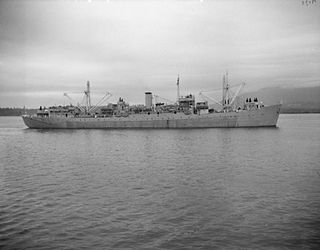
The Beachy Head-class repair ships were a class of 21 depot, maintenance and repair ships constructed for the Royal Navy during the Second World War. All of the ships in the class were constructed in Canada of which only five served in British waters during the war. Based on a modified mercantile design, five of the class were completed as merchant vessels after the war's end. Following the war, the majority were converted for mercantile use, with a further two ships ending up in service with the Royal Canadian Navy and another with the Royal Air Force.
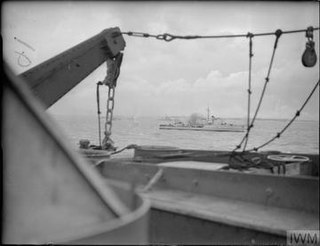
HMS Cottesmore was a Hunt-class destroyer of the British Royal Navy. The ship was built by the Scottish shipbuilder Yarrow at their Scotstoun, Glasgow shipyard in 1939–1940, being launched on 5 September 1940 and commissioning on 29 December that year.
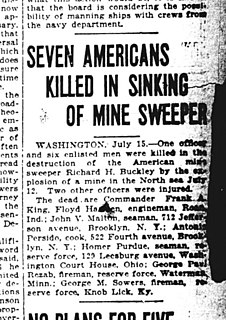
USS Richard Bulkeley was a minesweeping trawler leased from the British Royal Navy. Built as HMT Richard Bulkeley, the ship was a Mersey-class naval trawler, purpose built for service with the Auxiliary Patrol. On July 12, 1919, it was struck by an American Mk VI mine while removing minefields in the North Sea.

















